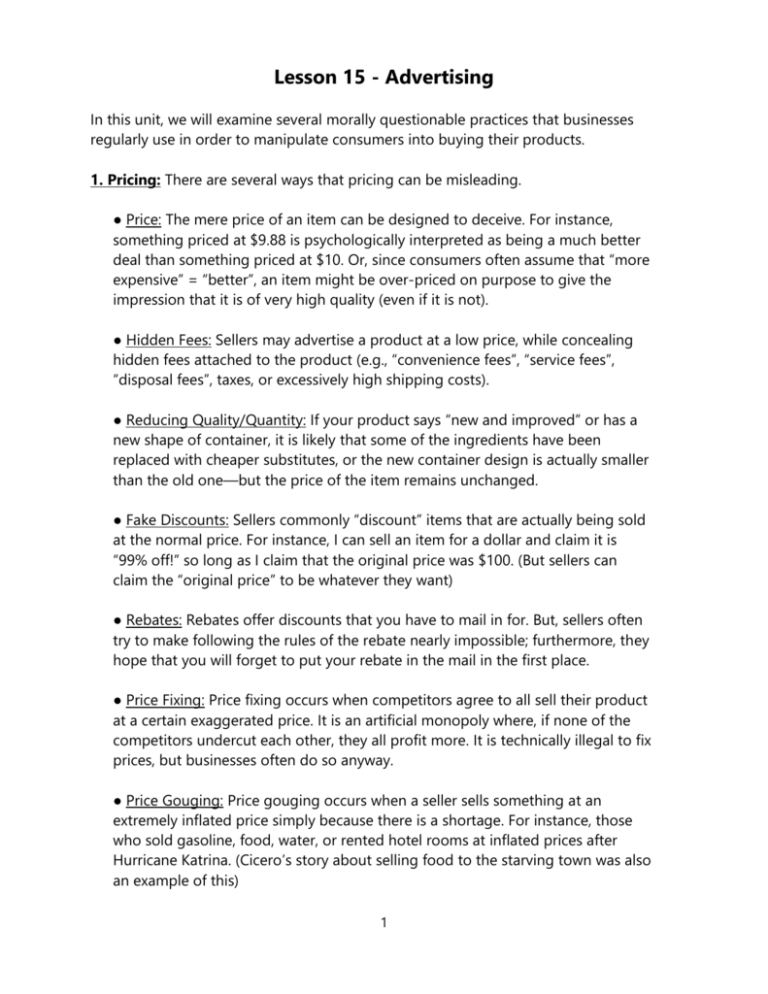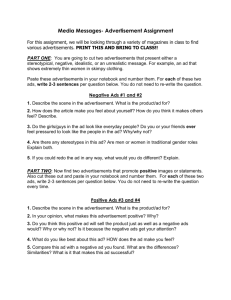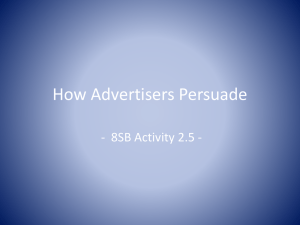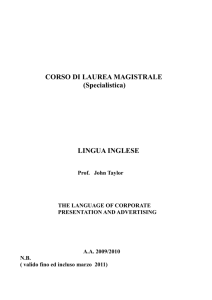Lesson 15 - Advertising
advertisement

Lesson 15 - Advertising In this unit, we will examine several morally questionable practices that businesses regularly use in order to manipulate consumers into buying their products. 1. Pricing: There are several ways that pricing can be misleading. ● Price: The mere price of an item can be designed to deceive. For instance, something priced at $9.88 is psychologically interpreted as being a much better deal than something priced at $10. Or, since consumers often assume that “more expensive” = “better”, an item might be over-priced on purpose to give the impression that it is of very high quality (even if it is not). ● Hidden Fees: Sellers may advertise a product at a low price, while concealing hidden fees attached to the product (e.g., “convenience fees”, “service fees”, “disposal fees”, taxes, or excessively high shipping costs). ● Reducing Quality/Quantity: If your product says “new and improved” or has a new shape of container, it is likely that some of the ingredients have been replaced with cheaper substitutes, or the new container design is actually smaller than the old one—but the price of the item remains unchanged. ● Fake Discounts: Sellers commonly “discount” items that are actually being sold at the normal price. For instance, I can sell an item for a dollar and claim it is “99% off!” so long as I claim that the original price was $100. (But sellers can claim the “original price” to be whatever they want) ● Rebates: Rebates offer discounts that you have to mail in for. But, sellers often try to make following the rules of the rebate nearly impossible; furthermore, they hope that you will forget to put your rebate in the mail in the first place. ● Price Fixing: Price fixing occurs when competitors agree to all sell their product at a certain exaggerated price. It is an artificial monopoly where, if none of the competitors undercut each other, they all profit more. It is technically illegal to fix prices, but businesses often do so anyway. ● Price Gouging: Price gouging occurs when a seller sells something at an extremely inflated price simply because there is a shortage. For instance, those who sold gasoline, food, water, or rented hotel rooms at inflated prices after Hurricane Katrina. (Cicero’s story about selling food to the starving town was also an example of this) 1 2. Advertising: Advertisements and commercials can be incredibly mis-leading. Businesses are often intentionally misleading, and do whatever they can to get you to buy their product. They do this in a number of ways: ● Ambiguity: A term or phrase is ambiguous if it can be interpreted in multiple, very different ways. Advertisers often use ambiguous terms, knowing that the consumer will interpret in one (favorable) way, when the truth is that it is meant to be interpreted in another way. A great example in the textbook is the term “light”. Sara Lee marked a line of “light” desserts. Customers interpreted this word as indicating that the desserts were lower in fat and calories than other desserts. In fact, the desserts contained just as much fat and calories as any other dessert—the word “light” referred only to the food’s texture. ● Vagueness: A term or phrase is vague if there is a whole spectrum of possible interpretations, which are all different degrees of the same concept. For instance, “helps” is a vague term. If I “help” you to do something, it can still be true if I did a LOT for you, or if I only did very LITTLE for you. So, advertisers use this word liberally. “Helps fight infection” or “helps you to lose weight” can still be true even if the product has almost zero actual effect. Other vague expressions, “Up to 8 hours of relief”, “As many as 80% of customers are satisfied”, “Virtually everyone agrees”, etc. These claims IMPLY far more than is actually the case, because each claim is qualified by a vague term, and the advertiser is therefore absolved of any blame or wrongdoing if the implied claims are far from true. ● Concealment of Facts: Advertisers will try to present their product in the best light possible. As such, they will tell you all of the good, while concealing all of the bad. Or, they will tell you irrelevant information which may SEEM good, or be interpreted as good. For instance, your “fat-free” coffee creamer has the words “fat-free” in big font, but fails to mention that it is loaded with high-fructose corn syrup, which is far worse for you than the fats that naturally occur in milk products, and is far more likely to put pounds on you than natural milk fats. A special subset of this are drug ads. While drug ads are required by law to list the risks and potential side-effects (i.e., it is ILLEGAL for them to suppress or conceal facts), advertisers try to minimize the focus on these risks, and distract their viewers from them as much as possible; as in the following ad: Drug Ads ● Puffery: Advertisers often throw in a lot of unnecessary positive adjectives into their ads, and possibly even other words that exaggerate the quality of the product. Words like “best”, “finest”, “ultimate”, “most”, or even words like “courage” and “trust”. See this humorous scene where Will Ferrell discovers the “World’s Best” cup of coffee. 2 ● Appeal to Emotion: Advertisers often skip appealing to your mind altogether, and go straight for your emotions instead. If the advertiser can make you “feel good” while watching the ad, you are more likely to associate that feeling with the product itself when you see it, and therefore be more willing to buy it. Though the following ad is a fake ad, it demonstrates some common deceptive tools that political ads. Viewers are constantly manipulated into feeling different emotions about candidates merely by the use of camera angles, music, fonts, and color schemes. Probably most of the effects in this ad will seem familiar to you: Fake Campaign Ad Sometimes, we’re misled to form the emotional feeling that something terrible will happen if we don’t buy the advertised product or service; as with this ad: Direct TV ● Subliminal Messages: Subliminal messages are pieces of information which occur so quickly, or are so small or unnoticeable, that we do not actually perceive them consciously—but our SUB-conscious mind notices everything, and DOES perceive it. If an ad uses a subliminal message, we may find ourselves associating some positive or enticing emotion or sensation with a product without any idea why. The most popular subliminal messages to insert into advertisements are sex and money. Most human beings desire both. So, if the advertiser can get your subconscious mind to associate either of those things with their product, you will be more likely to desire their product as well. Can you see the hidden money in the following image? 3 The image on the previous page appeared in a commercial for KFC snackers for less than a second, but that is long enough for the subconscious mind to register the dollar bill hidden in the lettuce. Can you see the hidden “sex” message in the following images? You’ve heard the saying, “Sex sells.” But, subliminal ads don’t need to be about money or sex. Sometimes, the ad can just be a normal one, but flashed so quickly that it is only registered by your subconscious mind, such as this subliminal McDonald’s Ad on Iron Chef. ● Marketing to Children: Another popular tactic is to market products to children. If children are appealed to at an early age, they are likely to grow up and become life-long consumers of the brand that they formed an attachment to as a child. Furthermore, children are great at getting their parents to buy things for them. If an advertisement can convince a child that they really need some item (and children are much easier to convince than adults), the child will then do all of the work of convincing the parents to buy it. 3. The Role of Regulation: Clearly, many (all?) of the above practices are immoral. Yet, businesses continue to market their products in these deceptive and misleading ways. Most people think that advertisements should be regulated in some way. The question, then, is, “HOW MUCH should advertisement be regulated?” There are two proposals: Either we regulate with the REASONABLE consumer in mind, or we regulate with the IGNORANT consumer in mind. 4 ● The Reasonable Consumer Standard: The view that we should prohibit only the sorts of advertisements which would be deceptive to the normal, reasonable consumer. ● The Ignorant Consumer Standard: The view that we should prohibit the sorts of advertisements which would even be deceptive to an ill-informed, naïve customer. Check out the following story on Credit Report Hidden Fees. The complaint of the consumers seems to be that very reasonable, normal people are being deceived by the ads for a “free” credit report and are getting tricked into purchasing a $15/month subscription. These consumers are appealing to a “Reasonable Consumer Standard”. Their claim is that, if a commercial deceives normal people, then the advertiser is doing something morally wrong. On the other hand, the credit report company’s official statement claims that “A very small percentage of consumers … genuinely do not understand.” In essence, they are saying that only ignorant consumers are being deceived, and so they are not doing anything wrong (so, the credit report company seems to be appealing to the “Ignorant Consumer Standard”). Who is right? As it turns out, the credit report ads were tricking thousands of people into purchasing monthly subscriptions, so—ignorant or not—the ads were unquestionably deceiving a significant number of people. We might, then, recommend a THIRD, alternative view about advertisement regulation: ● The “Modified” Consumer Standard: The view that we should prohibit the sorts of advertisements which would deceive significant numbers of people (regardless of whether those people are well-informed or ill-informed). Topic Suggestion: Advertisement #1: Most people agree that, if an advertisement will mislead or deceives the TYPICAL consumer, then it is wrong to do so. But, what about cases where an ad deceives only the “lowest common denominator” of society? Your textbook mentions a case where a hair-coloring company marketed their product as a “permanent hair coloring”. Most people know that human hair grows, and that the new hair (at its roots) will come in as your natural color—NOT as the dyed color. But, a few poorly informed or uneducated consumers were misled by the word “permanent” into thinking that they would only need to dye their hair once for the rest of their life! Was this advertisement in the wrong? Is an advertisement deceptive or morally wrong if it deceives only the very ignorant? Should we be taking regulatory measures to ensure that products have warnings and informative labels for EVERY consumer— even the very ill-informed? What do you think? (Remember: The worst that can happen in the hair dye case is that the customer will have grey roots and black hair. But, misinterpretation is often far more harmful than this. If an ill-informed person misinterprets a medication ad, for instance, they may lose their life.) 5 4. In Favor of Unregulated Advertising: We have said that deception in advertising is clearly immoral. But, some claim that certain kinds of deception are NOT immoral. ● We Want It: Some say that we NEED a bit of fantasy in our lives. We NEED to connect our products with a sense of adventure, magic, and success. So, the following advertisement is not a deceitful tactic designed to trick us into having an emotional attachment to the product; rather, the following ad is designed to give us some of that magic and adventure that we desire in life: Old Spice. Reply: Critics claim that such ads give us a false sense of hope and expectation, and causes many of us to be perpetually dissatisfied, or feel like our lives are missing something that we’re supposed to have. The present claim is that advertisers cater to our DESIRES. But, some have suggested that our desires WERE PUT THERE BY ADVERTISERS. You’ve probably heard of the old “Supply and Demand” theory; this says that, the more customers desire or “demand” a product, the more of it the manufacturers will produce, or “supply”. But, a theory called “The Dependence Effect” states just the opposite. This theory says that, if manufacturers MAKE more of something, this can cause the consumers to WANT more of it. Similarly, advertisements for certain products can CREATE a demand for those products. So, far from catering to our desires, this objection claims that advertisers are actually creating our desires. What do you think? ● It Will Benefit Us: Some attempt to defend unregulated advertising by claiming that a free, unregulated market will end up benefitting society as a whole. Reply: Does this sound familiar? It’s the same old “Invisible Hand” argument from Ethical Egoism and also Shareholder Theory. We have seen reason to believe already that unregulated business would probably not lead to a utopian society of maximum benefit for all. As your textbook points out, “The goal of advertisers is to sell you products and make money, not to promote your well-being.” ● Free Speech: The First Amendment guarantees freedom of speech; as such, one might think that advertisers are free to say whatever they want. Reply: The First Amendment does not give us unlicensed freedom to say WHATEVER we want WHENEVER we want. For instance, though there is freedom of speech in the United States, it is still wrong or illegal to use our speech to deceive, to incite violence, speak profanities (e.g., on certain television stations), slander someone, perjure in court, or shout “Fire!” in a crowded place. Similarly, the First Amendment does not give advertisers free reign to say whatever they want in their ads. They still have a duty to be honest, and to treat their potential viewers with respect. 6 Topic Suggestion: Advertisement #2: Feel free to share some personal story of an advertisement or commercial which you found to be deceiving. Perhaps you were deceived by the price of something, or the wording, or the implications. Feel free to post links to youtube videos as well, if your story involves a commercial that can be found on the internet. 7







